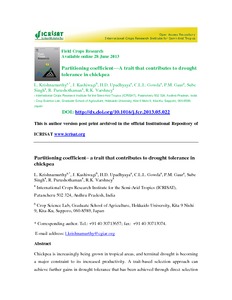Partitioning coefficient—A trait that contributes to drought tolerance in chickpea
Abstract
Chickpea is increasingly being grown in tropical areas, and terminal drought is becoming a major constraint to its increased productivity. A trait-based selection approach can achieve further gains in drought tolerance that has been achieved through direct selection for yield. Separation of yield into its components including the rate of partitioning and its duration could permit a better focus on the most relevant trait for yield enhancement under terminal drought. Current work is aimed at understanding the importance of rate of partitioning or the partitioning coefficient (p) as a major contributory trait associated with drought tolerance both in germplasm and breeding lines. A reference collection of chickpea germplasm (n = 280) was evaluated in the field under both terminal drought and optimally irrigated environments; and a set of desi (n = 60) and kabuli (n = 60) advanced breeding lines under terminal drought. Grain yield was associated with its analytical components – crop growth rate (C), reproductive duration (Dr) and p. The path analysis showed that C and p had a large direct positive contribution to yield while Dr had a marginal but negative contribution to yield under drought. The direct contribution of p was the highest but it was marginally reduced by the indirect negative contributions of Dr. However, the total contributions of p to grain yield remained large. The yield of germplasm accessions under drought across the seasons were closely associated (r2 = 0.70) and also the genotype × year interaction was minimum. The contribution of C, Dr and p to grain yield were similar in the advanced breeding lines. However, kabuli breeding lines had a larger variation for p than the desi lines. The results suggest that a conscious selection for greater p will confer greater tolerance to abiotic stresses, given that terminal drought tends to curtail the length of the reproductive period

